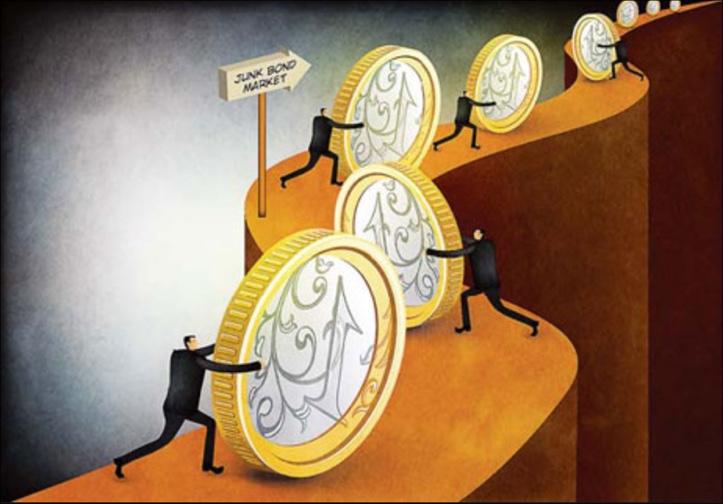It's been a while since I last looked at junk-bond yields so I was flabbergasted at one point last week when I checked FRED, the research arm of the Federal Reserve. The yield on the “Bank of America Merrill Lynch US High Yield Effective Yield” was down to just a tad above 6%. I get that interest rates are low. Still, there has to be some point at which we just say “No,” especially since big-name ETF providers feature such temptations as SPDR Barclays High Yield Bonds (JNK) and iShares iBoxx High Yield Corporates (HYG) and, hence, make it easier than ever for the average possibly unwary but definitely yield-craving investors to get up to their eyeballs in this stuff.
Actually, my shock at how low the yield was has something to do with the fact that this is a market I haven't watched closely in many years. In fact, the current yield is not as low as it's been in the recent past. It bottomed on 6/25/14 at 5.19%. But that was a pretty bad time to be in these instruments as yields did a u-turn and shot up to 9.78 by 2/10/16. So it's entirely possible that notwithstanding the market's sudden burst of Fed angst, the yield might again test or even surpass prior lows But it's not as if that prospect makes these worth owning. (How many of yield chasers who climbed aboard in early 2014 do you think sold by June 25th?)
Forget the Fed for a moment. I know that's hard to do, but sometimes, there are other things we have to consider, such as, what junk bonds really are about.
Introducing Junk Bonds
I assume by now we all know about credit risk and have learned to wink when funds such as the ETFs cited above have legal names that refer to “high yield” or something like that. But junk is junk whatever the lawyers and marketers call it. Back in the Michael Milken –Drexel Burnham heyday, the junk bond fund I managed used the phrase “Aggressive income.” Other than the one shareholder that called me when publicity about that era's big scandal was raging to say, “Thank God we're not in junk bonds,” everybody else knew the score.

Junk bonds are called junk bonds because they are . . . well, junk. Many of the issuers can't afford to pay the interest. There are two types of junk bonds. One is the fallen angel. This is a bond that was decent when it started but became junk because the creditor-company later fell on hard times. The other, and eventually more popular, category is original-issue junk, which means it's issued as junk from day one and is never expected to be traded other than on specialized trading desks dedicated specifically to junk, oops, I mean high yield.
Original-issue junk had two flavors all its own. The infamous portion of this market consisted debt used to finance acquisitions, leveraged buyouts, etc. The idea was that cash flows would be improved after the purchase and/or surplus assets sold in order to repay debt and make the equity (and possibly whatever debt was left over) much more valuable. Sometimes, these bonds were issued with a specific purchase in mind. Other times, companies issued bonds to accumulate war chests, which they would keep in their back pockets while they hunted for victims; I mean prospective acquisition targets. And then there was the plain-vanilla original-issue junk bonds that were functionally like equity IPOs (ways to raise capital) but which substituted higher risk (fixed interest-expense obligations) and higher potential returns (the equity holders would not have to share future profit growth with additional outside shareholders).
Why The Risk Is Supposed To Be OK
All of these categories of bonds are very risky and that's why they have higher yields. Lenders (or in the case of junk-bond ETFs, the ETF shareholders) are supposed to be protected by (i) a yield premium that is high enough to make for a reasonable enough portfolio return even if we assume, as we absolutely must, some bonds will blow up, (ii) covenants, contractual agreements with bondholders, that limit management's ability to do crazy things that will later make the bods riskier than the market thought they would be at the time of issuance, (iii) and a capital structure hierarchy that gives bondholders prior claims against corporate assets.



